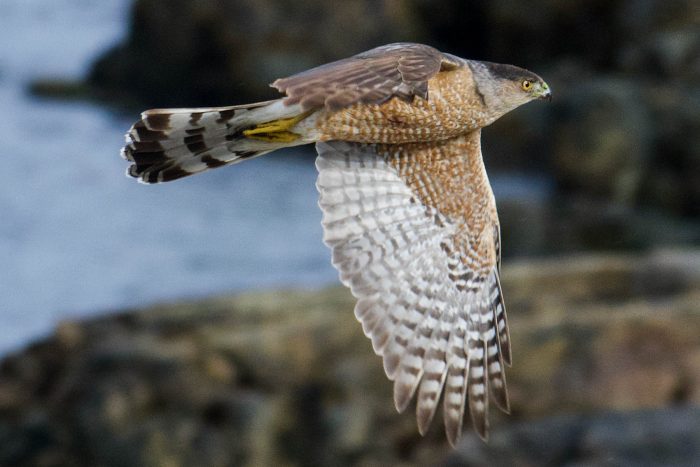Cooper's Hawk
Accipiter cooperii
The Cooper's hawk is a mid-sized hawk with broad, rounded wings and a long tail. It can be found year-round in wooded areas throughout most of the Chesapeake Bay watershed.
This section shows one large critter image at a time. Use the thumbnails that follow to select a specific image to display here.

This gallery contains a grid of small thumbnails. Selecting a thumbnail will change the main image in the preceding section.
Appearance
The Cooper’s hawk is a medium-sized hawk with broad, rounded wings and a very long tail. It has a black crown and a hooked bill, and its eyes range from yellow to deep red. Adults are steely blue-gray above with warm reddish bars underneath and thick dark bands on the tail. Juveniles are brown above with brown streaks on the upper breast. Females are generally much larger than males, averaging 16 inches in length with a 29 to 36-inch wingspan, while males average 15 inches in length with a 24 to 35-inch wingspan.
Feeding
Falcons tend to kill their prey by using their sharp beaks, but Accipiter hawks like the Cooper’s hawk capture prey with their feet and squeeze them, holding the catch away from their bodies until it dies. These hawks mainly eat small birds like starlings, doves, and pigeons, but have been known to rob nests and eat small mammals like chipmunks, mice, squirrels and bats. The Cooper’s hawk hunts by stealth, quietly approaching its prey under forest cover and rapidly pouncing. They will fly fast and low to the ground, then quickly pop up to surprise prey.
Predators
Raccoons and Great Horned Owls are common predators of eggs and nestlings.
Flight
These hawks fly with a flap-flap-glide pattern and rarely flap continuously. In pursuit of prey, their flight becomes powerful and agile as they thread through tree branches at top speed.
Voice
Outside of breeding, Cooper’s hawks tend to be silent. The most common call is a cak-cak-cak, given while defending the nest or during courtship.
Reproduction and life cycle
Many Cooper’s hawk pairs mate for life. Breeding begins as early as March. Males will build the nest, which are piles of sticks lined with bark or green twigs, typically 25 to 50 feet off the ground in a pine oak, fir or other tree. Females lay a clutch of 3 to 5 pale bluish-white eggs. Males then provide nearly all the food to females and young before the young fledge. Young can fly at about 4 to 5 weeks.
Did you know?
- Cooper’s hawk populations declined in the mid-20th century, possibly due to the use of DDT and other pesticides.
- These birds were named after naturalist William Cooper, who collected the specimens that were used to describe the species.
- Cooper’s hawks prey on small mammals like mice that may be pests to farmers or households. Occasionally, the birds will prey on domestic chickens, but this occurs infrequently and is balanced by their hunting of pests that could otherwise cause significant damage to crops.
Sources and additional information
- All About Birds: Cooper’s Hawk – The Cornell Lab of Ornithology
- Cooper’s Hawk – Audubon Field Guide to North American Birds
- Animal Diversity Web: Accipiter cooperii – University of Michigan Museum of Zoology
- Cooper’s Hawk – Hawk Mountain
